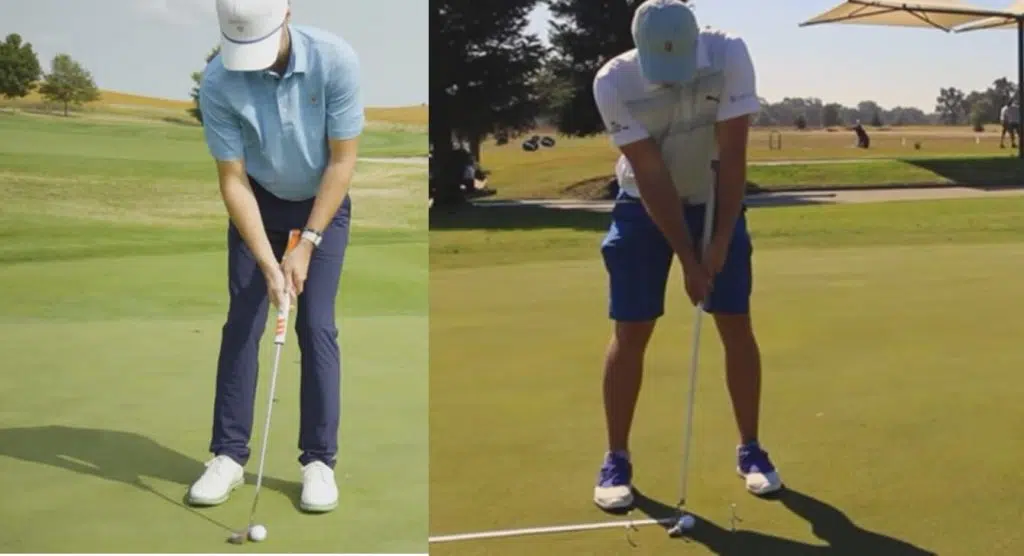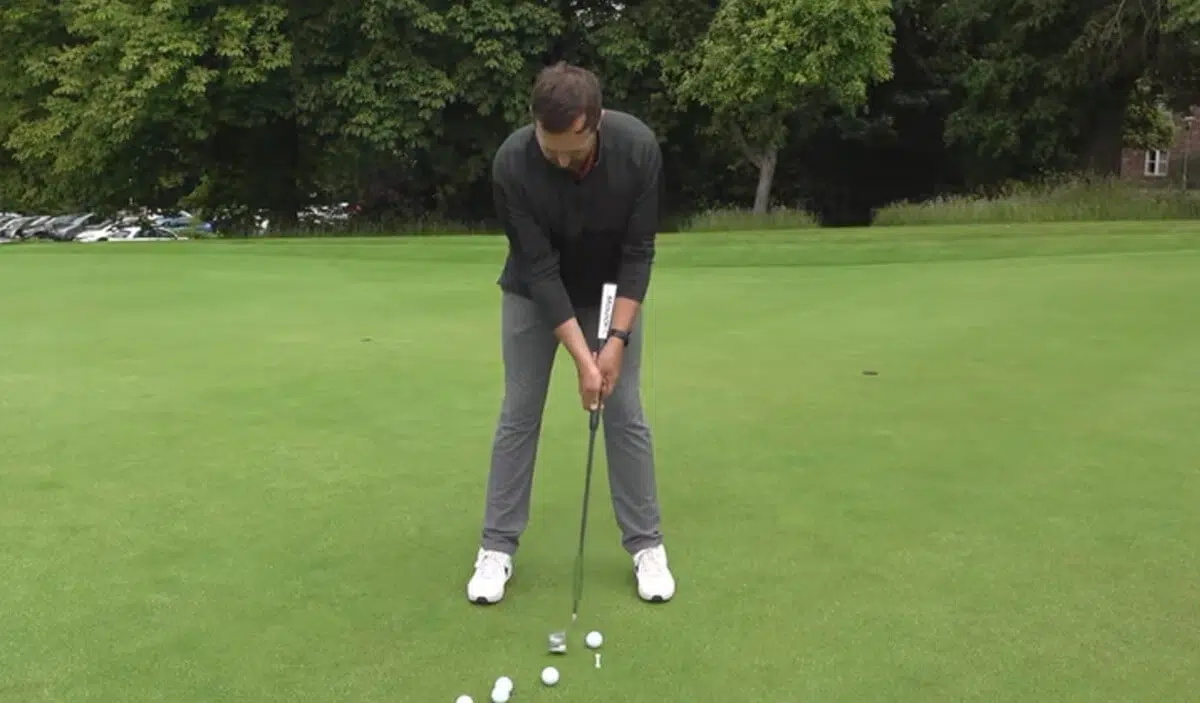Wrist Lock putting is basically a sub-category of Arm Lock putting. In this comparison post, we look at the key differences and the key similarities between arm lock putting vs wrist lock putting.
Key Differences - Wrist Lock vs Arm Lock Putter
1. The Amount of Forward Shaft Lean
One aspect of arm lock putting that can be quite awkward at first is the amount of forward shaft lean that an arm lock putter promotes.
In order to hold an arm lock putter flat against your wrist, you have to reduce the angle that typically exists between your hand and your wrist when holding a putter. So instead of pointing your hand straight downwards, you are actually creating a straight line with your hand and your wrist. It’s almost like your arm, wrist, and hand all become an extension of the putting triangle.
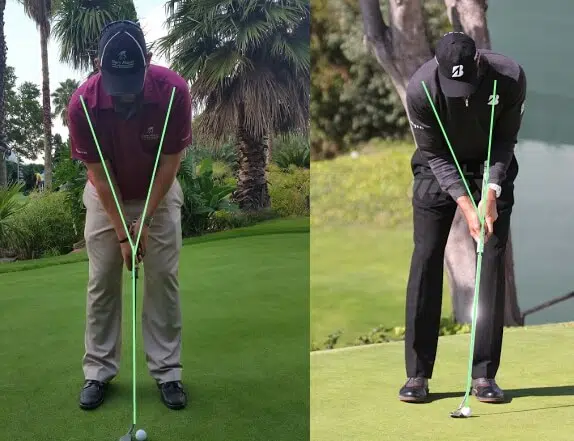
The consequence of this setup is that it leads to an exaggerated forward shaft lean. It could be called a forward press on steroids.
With a wrist lock putter, the grip is built with a curve on the one side of the putter grip that slots into your wrist/inner forearm. This makes it easier to hold a wrist lock putter, without an excessive amount of shaft lean. Wrist Lock putters still promote a forward press, but it is less extreme than the forward press promoted by an arm lock putter.
2. Wrist Lock Putters Have Lower Lofts
In order to counteract the forward shaft lean that is required to hold an arm lock putter, the loft of the putter is usually between 6-8 degrees. Because a forward shaft lean effectively delofts a putter face, the extra loft is added to the putter face, in order to ensure an effective loft of about 3 degrees.
Said another way, the setup that you employ when holding an arm lock putter decreases the putter loft by about 4 degrees. To counteract this delofting effect, club manufacturers add an extra 3 -5 degrees to the putter face.
With a WristLock Putter, the loft is usually between 4-5 degrees. This is still higher than a standard putter (approximately 3 degrees), but notably less than an arm lock putter (6 – 8 degrees). Again, because WristLock putters promote a more subtle forward press, it isn’t necessary to add that much extra loft to the putter face. 1-2 degrees should be fine for most players.
3. Wrist Lock Putters Tend To Be Slightly Shorter
With an arm lock putter, it is common for the grip to rest against the full length of the forearm, almost reaching the elbow joint. For most male players, this results in a putter length of 40 – 42 inches.
With a wrist lock putter, the rule of thumb is to take your current putter length, and simply add 5-6 inches. For most players, this results in a putter length of about 38-40 inches.
4. Arm Lock Putting Is Far More Common with Professional Golfers
While Arm Lock Putters are only used by a small percentage of professional players, WristLock putters are used by almost no professionals. This is partially because the product category is so new. Most professionals have spent thousands of hours practicing their putting strokes with standard length putters. It’s only when things start to go deeply wrong that a pro will consider switching to an arm lock putter.
In order for WristLock putters to gain a bit more traction, more high profile professionals will need to put one in their bag. At this point in time, the only notable player using a WristLock setup is Phil Mickleson.
5. It Is Easier To Hold A Putter with A WristLock Grip
Holding a WristLock grip isn’t all that different to holding a normal putter grip. You start off by holding the putter grip in your left hand and then implement a slight forward press to lock it into place. The curve of the grip should fit snugly into the lower part of your wrist (where your hand and wrist connect).
With an arm lock putter, you will have to spend some time working out how to get the grip to sit flat against your left forearm. For most golfers, it requires an extreme forward press and an oversize arm lock putter grip. This is exactly how Bryson DeChambeau does it.
6. A WristLock Grip Can Be Used with A Standard Length Putter
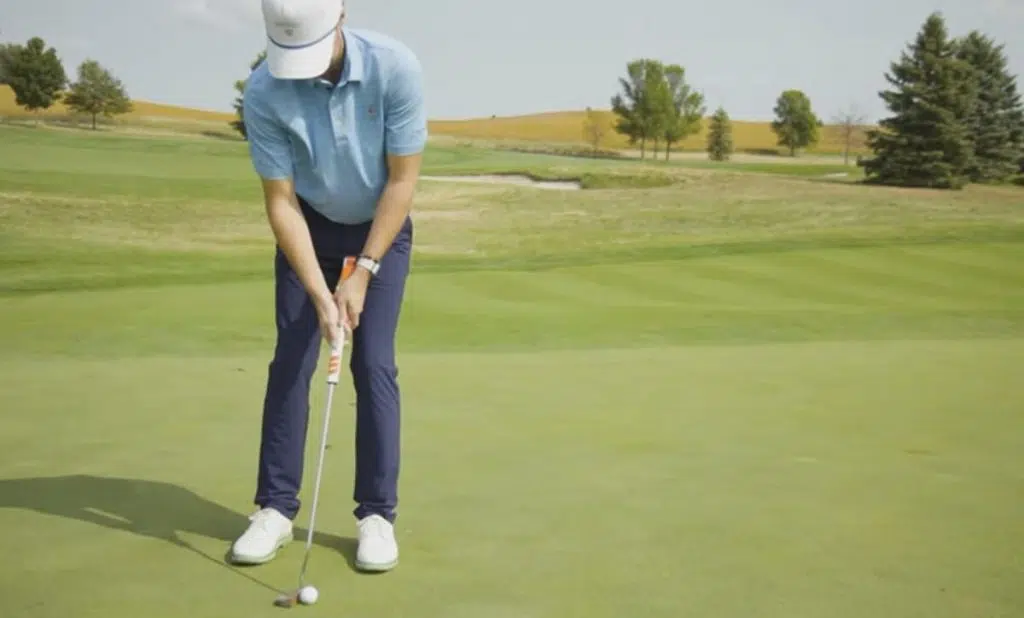
Technically speaking, there’s nothing preventing you from installing a WristLock grip in a standard length putter. It might not be the perfect WristLock setup due to a standard putter being too short and the loft being too low, but it will give you pretty good sense of whether or not this putting style can actually work for you.
To this end, installing a WristLock putter grip on one of your older putters is a low-risk way to experiment with this putting style. Instead of dropping $400 on a WristLock putter, you can get a good sense of what WristLock putting is all about with a $29 WristLock grip. If you gel with the method, then you can consider customizing your existing putter or invest in a new WristLock putter.
Key Similarities - Wrist Lock vs Arm Lock Putter
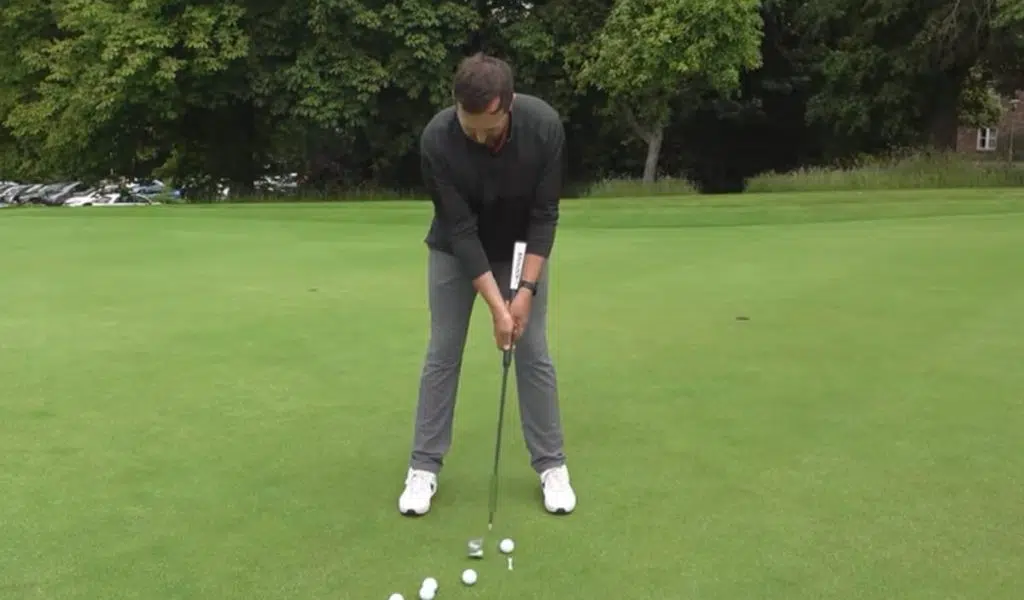
1. The Grip Is Designed To Rest Against The Lead Forearm
The key similarity between WristLock putting and ArmLock putting is that the grip of the putter rests against the inside of the left forearm. The extra forearm stability offered by both of these methods is what makes them so enticing.
Instead of having a shaky or wristy putting stroke, you gain massive wrist stability and the ability to drive your putting stroke with your shoulders primarily. Both of these putting methods allow you to take your hands out of the stroke, which can be very advantageous if you struggle with short putts or have a case of the putting yips.
2. Arm Lock Putters and WristLock Putters Are Longer Than Standard Length Putters
While Arm Lock putters tend to be slightly longer than WristLock putters, they are both considerably longer than standard length putters.
Wrist Lock putters are about 4-6 inches longer than standard putters. Armlock putters are about 6-8 inches longer than standard putters.
Both types of putters will usually be between 38 and 42 inches long, depending on the preferences of the player.
3. Both Putting Styles Are 100% Legal In Tournament Play
It is worth noting that both Arm Lock Putting and Wrist Lock putting are 100% legal in tournament play, for amateurs and professionals.
There are some putting purists like Billy Horschel that have called for Arm Lock putting to be banned. However, the USGA is unlikely to amend the anchoring rule any time soon. This means that both Wrist Lock Putting and Arm Lock putting are likely to remain 100% legal, for many years to come.

